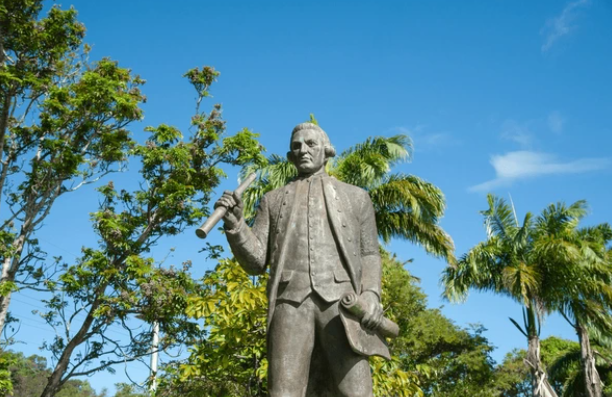Introduction: The Historic Claim of New South Wales
Captain James Cook Claims New South Wales for Britain – In 1770, Captain James Cook, a British explorer and naval officer, made one of the most significant acts in Australian history by claiming the eastern coast of Australia, specifically New South Wales, for the British Crown. This event marked the beginning of British interest in the Australian continent and set the stage for the eventual colonization that would forever alter the history and landscape of Australia.
Captain Cook’s journey aboard the HMS Endeavour was part of a broader scientific expedition, but his discovery and subsequent claim of Australia had profound geopolitical and cultural ramifications. This article explores the context, voyage, and impact of Captain Cook’s claim of New South Wales, offering insights into how this moment shaped the future of Australia.
Read Also : Willem Janszoon Arrival in Queensland (1606) : The First European Contact with Australia
The Context of 18th Century Exploration: The Race for New Territories
The 18th century was a period of intense exploration and expansion for European powers, driven by a combination of scientific curiosity, economic interests, and strategic imperatives. The British, alongside other European nations, were keen to discover new lands, establish trade routes, and expand their empires.
The Role of the Royal Society and Scientific Exploration
Captain Cook’s voyage to the Pacific, including the eastern coast of Australia, was primarily commissioned by the Royal Society, a prestigious scientific institution in Britain. The primary objective of the voyage was to observe the transit of Venus across the sun, a rare astronomical event that could provide valuable data for calculating the distance between the Earth and the Sun.
However, the voyage had a secondary, yet equally important, objective: to explore and map the unknown southern lands, often referred to as Terra Australis Incognita, and to search for potential new territories for Britain. The Royal Society’s involvement reflects the intersection of scientific inquiry and imperial ambition that characterized much of the exploration during this period.
The importance of scientific exploration was not merely academic; it was tied to broader strategic goals. Understanding the geography of the world, discovering new lands, and mapping potential resources were all critical components of expanding and maintaining an empire. The Royal Society’s support of Cook’s voyage exemplified the synergy between science and empire in the 18th century.
The Strategic Interests of the British Empire
By the late 18th century, the British Empire was one of the most powerful global forces, with colonies in North America, the Caribbean, and India. However, the loss of the American colonies following the Revolutionary War heightened the British government’s interest in expanding their influence in other parts of the world.
Australia, a largely unknown and unclaimed continent, represented a new opportunity for expansion. The strategic location of Australia in the Pacific, along with its potential resources, made it an attractive prospect for the British Empire. The need to secure new territories, particularly after losing the American colonies, added urgency to British exploration efforts.
The British were also motivated by the desire to prevent other European powers, particularly the French and Spanish, from claiming new territories in the Pacific. The race for global dominance drove European powers to explore and claim lands that were previously unknown to them, often with little regard for the Indigenous populations that already inhabited these regions.
European Knowledge of Australia Before Cook
Before Captain Cook’s voyage, European knowledge of Australia was limited and fragmented. While Dutch explorers, including Willem Janszoon and Abel Tasman, had made earlier voyages to the western and southern coasts of Australia, these explorations did not lead to permanent settlements or detailed maps of the continent.
The Dutch named the land they discovered “New Holland,” but their explorations were primarily focused on the western and northern coasts, with little interest in the eastern coast. The harsh conditions, lack of obvious resources, and conflicts with Indigenous peoples discouraged further exploration by the Dutch.
Other European nations, including the Spanish and Portuguese, had also explored parts of the Pacific, but Australia remained largely unknown to them. Captain Cook’s voyage represented the first systematic exploration and mapping of the eastern coast of Australia, providing valuable information that would shape European perceptions of the continent.
The Voyage of the Endeavour: Discovering and Claiming New South Wales
Captain James Cook’s voyage aboard the HMS Endeavour is one of the most famous and well-documented journeys in the history of exploration. Cook’s journey took him from the Pacific islands of Tahiti to the eastern coast of Australia, where he made the historic claim of New South Wales for Britain.
The Preparation and Objectives of the Voyage
The voyage of the Endeavour was meticulously planned and prepared. The Royal Society, in conjunction with the British Admiralty, selected James Cook, a skilled navigator and cartographer, to lead the expedition. Cook’s experience in mapping and surveying made him the ideal candidate for the mission.
The Endeavour was outfitted with the latest navigational instruments, provisions for a long journey, and a crew of sailors, scientists, and artists. The inclusion of scientists, including the botanist Joseph Banks, reflected the dual objectives of the voyage: scientific exploration and territorial discovery.
The primary scientific objective of the voyage was to observe the transit of Venus from Tahiti, which was successfully accomplished in June 1769. Following this, Cook was instructed to continue his journey southward to explore the unknown eastern coast of New Holland and to search for the mysterious southern continent.
The Discovery of the Eastern Coast of Australia
In April 1770, after months of navigating the treacherous waters of the Pacific, Cook and his crew sighted the eastern coast of Australia. They first landed at a place Cook named Botany Bay, due to the abundance of unique plant life observed by Joseph Banks and the expedition’s naturalists.
The landing at Botany Bay marked the first European encounter with the eastern coast of Australia. Cook and his crew spent several days exploring the area, collecting specimens, and interacting with the Indigenous peoples they encountered. The crew’s observations of the land’s potential for settlement and agriculture contributed to the decision to claim it for Britain.
After leaving Botany Bay, Cook continued to sail northward along the eastern coast, mapping the coastline and making additional landfalls. The detailed charts and observations made during this journey provided the first comprehensive European understanding of the eastern coast of Australia.
Claiming New South Wales for Britain
On August 22, 1770, near what is now known as Possession Island in Queensland, Captain Cook performed the formal act of claiming the eastern coast of Australia for the British Crown. He named the claimed territory New South Wales, a name that would later come to signify the entire eastern portion of the Australian continent.
The act of claiming New South Wales was conducted in accordance with the British legal and ceremonial traditions of the time. Cook took possession of the land in the name of King George III, raising the British flag and declaring the territory under British sovereignty.
Cook’s claim of New South Wales was based on the doctrine of terra nullius, a legal concept that allowed European powers to claim lands that were deemed “empty” or unoccupied. This doctrine ignored the presence of Indigenous peoples and their long-standing connection to the land, setting the stage for future conflicts and displacement.
Indigenous Peoples and First Contact: Encounters with the Gweagal People
Captain Cook’s arrival on the eastern coast of Australia marked the first recorded contact between Europeans and the Indigenous peoples of the region. These initial encounters were characterized by curiosity, caution, and, at times, conflict.
The Gweagal People of Botany Bay
The first Indigenous people encountered by Captain Cook and his crew were the Gweagal, a clan of the Dharawal nation, who lived around the area now known as Botany Bay. The Gweagal people had inhabited the region for thousands of years, with a deep connection to the land and a rich cultural heritage.
The Gweagal people were hunter-gatherers, relying on the abundant natural resources of the area for their food and materials. Their knowledge of the land, including its plants, animals, and seasonal cycles, allowed them to live sustainably in the region.
The arrival of the Endeavour was likely a surprising and unsettling event for the Gweagal people. The sight of a large European ship, unlike anything they had seen before, would have been both intriguing and alarming. The Gweagal’s initial response to the strangers was one of caution and defense, as they sought to protect their land and people.
The First Encounters: Curiosity and Conflict
The first encounters between Captain Cook’s crew and the Gweagal people were marked by a mix of curiosity and conflict. Cook and his crew, eager to explore the land and interact with its inhabitants, approached the Gweagal with gifts and attempts at communication. However, the language barrier and cultural differences made meaningful communication difficult.
The Gweagal people, unfamiliar with the intentions of the newcomers, reacted with caution and defensive measures. During one of the encounters, a group of Gweagal men attempted to resist the landing of the Europeans by brandishing spears. In response, Cook ordered his men to fire warning shots, which resulted in the wounding of two Gweagal men.
The exchange of gunfire marked a turning point in the encounter, with the Gweagal retreating from the immediate area. Cook’s crew, now able to land without resistance, explored the area, collected specimens, and took note of the Indigenous people’s tools and structures. However, the violence of the encounter set a precedent for future interactions between Europeans and Indigenous Australians.
Observations and Misunderstandings
The interactions between Cook’s crew and the Gweagal people were characterized by misunderstandings and differing worldviews. The Europeans observed the Gweagal’s lifestyle and tools with a sense of superiority, often viewing them through the lens of European norms and values. This led to misconceptions about the sophistication and complexity of Indigenous Australian societies.
For example, Cook’s crew noted the Gweagal’s use of simple tools, such as stone-tipped spears and wooden shields, and mistakenly assumed that they were a “primitive” people. They failed to recognize the deep knowledge and intricate social structures that underpinned the Gweagal’s way of life.
The Gweagal people, on the other hand, would have viewed the Europeans as strange and potentially dangerous intruders. Their attempts to defend their land were met with force, reinforcing their caution and suspicion towards the newcomers.
These early encounters set the tone for future interactions between Indigenous Australians and European settlers. The misunderstandings and conflicts that arose from these first contacts would continue to shape the relationship between the two groups for centuries to come.
The Impact of Captain Cook’s Claim: Short-Term and Long-Term Consequences
The consequences of Captain Cook’s claim of New South Wales for Britain were far-reaching, both in the immediate aftermath of the voyage and in the long-term development of Australia as a British colony.
Immediate Reactions in Britain
The immediate reaction to Captain Cook’s claim of New South Wales was one of interest and strategic consideration. The British government, recognizing the potential of the newly claimed territory, began to consider the possibilities of establishing a colony in the region.
However, it was not until nearly two decades later, in 1788, that the British would establish their first permanent settlement in Australia, with the arrival of the First Fleet at Botany Bay. The delay in colonization was due to a variety of factors, including the ongoing conflict in North America and the logistical challenges of establishing a colony so far from Britain.
Despite the delay, Cook’s voyage and his claim of New South Wales were pivotal in shaping British policy towards Australia. The detailed charts and observations made during the voyage provided valuable information for future expeditions and laid the groundwork for the eventual colonization of the continent.
The Long-Term Impact on Indigenous Australians
The long-term impact of Captain Cook’s claim on Indigenous Australians was profound and devastating. The doctrine of terra nullius, which underpinned the British claim to the land, ignored the existence of Indigenous peoples and their deep connection to the land. This doctrine justified the subsequent dispossession, displacement, and marginalization of Indigenous Australians.
The arrival of European settlers in the late 18th and early 19th centuries brought significant changes to the lives of Indigenous Australians. The introduction of new diseases, the loss of land, and the disruption of traditional ways of life had a devastating impact on Indigenous communities. The effects of colonization are still felt today, with Indigenous Australians continuing to face social, economic, and cultural challenges.
The legacy of Captain Cook’s claim is a complex and contentious one. While it marked the beginning of modern Australia, it also set in motion a process of colonization that had lasting and often negative consequences for Indigenous Australians.
The Development of New South Wales as a British Colony
The establishment of New South Wales as a British colony in 1788 was directly linked to Captain Cook’s claim. The First Fleet, led by Captain Arthur Phillip, arrived at Botany Bay with the intention of establishing a penal colony. The colony quickly grew, expanding beyond Botany Bay to Port Jackson (now Sydney) and eventually becoming the foundation of modern Australia.
The development of New South Wales as a British colony involved the expansion of settlements, the exploitation of natural resources, and the establishment of British legal and political systems. The colony attracted free settlers, convicts, and entrepreneurs, leading to rapid growth and the eventual establishment of other colonies across Australia.
The impact of British colonization on the Australian landscape was profound. The introduction of European agriculture, the displacement of Indigenous peoples, and the development of infrastructure transformed the continent. The legacy of this period is still evident in Australia’s cities, legal systems, and cultural practices.
The Global Significance of Captain Cook’s Voyage
Captain Cook’s voyage and his claim of New South Wales had global significance, influencing European perceptions of the Pacific region and contributing to the broader expansion of the British Empire. Cook’s detailed charts and observations were widely circulated, providing valuable information for future explorers and traders.
The success of Cook’s voyage also reinforced the importance of scientific exploration in the 18th century. The combination of scientific inquiry and territorial discovery exemplified the Enlightenment ideals of progress and knowledge. Cook’s achievements were celebrated in Britain and throughout Europe, contributing to his lasting legacy as one of history’s greatest explorers.
However, the global significance of Cook’s voyage also includes the darker aspects of European expansion. The encounters between Europeans and Indigenous peoples often led to the exploitation and marginalization of native populations. Cook’s claim of New South Wales is a reminder of the complex and often contentious legacy of European exploration and colonization.
Commemoration and Controversy
Captain Cook’s claim of New South Wales has been commemorated in various ways throughout Australian history. Monuments, place names, and annual events celebrate Cook’s achievements and his role in the “discovery” of Australia. However, these commemorations are not without controversy.
For many Indigenous Australians, Cook’s arrival and the subsequent colonization of their lands are associated with loss, dispossession, and the disruption of their cultures. The commemoration of Cook’s achievements is often seen as overlooking the negative impact of colonization on Indigenous communities.
In recent years, there has been a growing movement to reconsider how Captain Cook’s legacy is remembered and taught. Efforts to include Indigenous perspectives and recognize the complexities of Australia’s history are part of a broader push for reconciliation and a more inclusive understanding of the nation’s past.
Conclusion: Reflecting on Captain James Cook’s Claim of New South Wales
Captain James Cook’s claim of New South Wales in 1770 is one of the most significant events in Australian history. It marked the beginning of British interest in the Australian continent and set the stage for the eventual colonization that would transform the land and its peoples.
While Cook’s voyage is celebrated for its contributions to exploration and science, it is also a reminder of the complex and often painful history of European expansion. The claim of New South Wales, based on the doctrine of terra nullius, disregarded the presence of Indigenous Australians and paved the way for their dispossession and marginalization.
Reflecting on this history provides valuable insights into the challenges and consequences of exploration and colonization. It also highlights the importance of acknowledging and addressing the legacies of the past in order to build a more inclusive and reconciled future for all Australians.
FAQ About Captain James Cook’s Claim of New South Wales
Who was Captain James Cook?
Captain James Cook was a British explorer, navigator, and cartographer who is best known for his three voyages to the Pacific Ocean. In 1770, he became the first European to map the eastern coast of Australia and claimed the territory of New South Wales for Britain.
Why did Captain Cook claim New South Wales for Britain?
Captain Cook claimed New South Wales for Britain as part of his mission to explore and map unknown territories. The claim was made in accordance with British legal and ceremonial traditions, and it was driven by strategic interests in expanding the British Empire.
What was the impact of Cook’s claim on Indigenous Australians?
The impact of Cook’s claim on Indigenous Australians was profound and often negative. The claim disregarded the presence of Indigenous peoples and their connection to the land, leading to their dispossession, displacement, and marginalization during the subsequent colonization of Australia.
How is Captain Cook’s legacy viewed today?
Captain Cook’s legacy is viewed with both admiration and controversy. While he is celebrated as a great explorer and contributor to scientific knowledge, his role in the colonization of Australia and its impact on Indigenous Australians is increasingly recognized and debated.
What is the significance of Captain Cook’s voyage?
Captain Cook’s voyage is significant because it marked the beginning of British interest in Australia and provided the first detailed maps and observations of the eastern coast. The voyage also exemplified the intersection of scientific exploration and imperial expansion during the 18th century.







1 comment